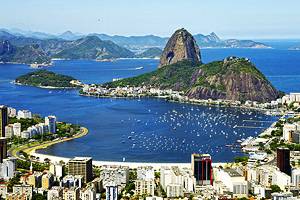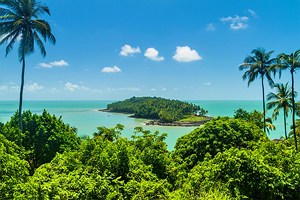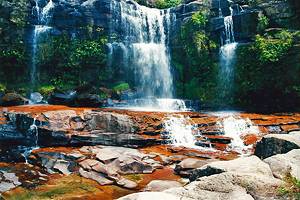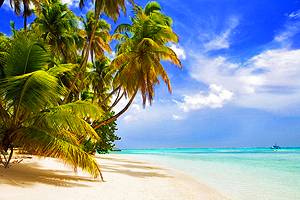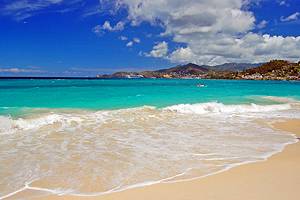Tourist Attractions in Manaus
Rubber transformed the little settlement at Fort São José, where the Rio Negro meets the Rio Solimões, into the wealthy and cosmopolitan metropolis of Manaus. In the decades before Asian competition drove down the price of rubber in the early 20th century, Manaus, Brazil became so prosperous that grand public and private buildings were constructed of costly materials imported from Europe.
Today, as capital of Amazonas state and a busy free trade zone, it is the jumping-off point for exploring the Amazon and its headwaters. Its primary tourist attractions, in addition to its colonial buildings, are the many eco-tour options by boat and to lodges in the nearby tropical rain forests.
You can be sure to see the highlights of this fascinating area with our handy list of the top tourist attractions in Manaus.
Teatro Amazonas: An Italian Renaissance-style Opera House

The city's most famous building is the Italian Renaissance-style opera house opened in 1896 and now protected as a national monument. In an effort to make Manaus a great center of civilization, no expense was spared to create this cultural palace in the heart of the primeval forest.
Most of its materials were imported from Europe: the doorways are of Italian marble, the staircase is of English wrought-iron, and many of its 198 chandeliers are of Murano glass from Venice; the rest were imported from France. The dome, completed at the beginning of the 20th century, is faced with 36,000 tiles imported from Germany. Even the native Brazilian woods used in the palace's decoration were sent to Europe to be carved and polished.
The curtain, which rises flat without being rolled or folded, shows the junction of the Rio Negro and the Solimões to form the Amazon. When the rubber market declined, and the Manaus barons left with their fortunes, the theater fell into disrepair. It was only restored in the late 1980s and is again used for its original purpose.
Address: Avenida Eduardo Ribeiro, Manaus, Amazonas
Encontro das Aguas

It would be unthinkable to travel to Manaus without seeing Encontro das Aguas, one of the world's natural wonders. This is the point, 20 kilometers southeast of the city, where the dark-colored water of the Rio Negro joins the light brown muddy water of the Rio Solimões to form the Amazon.
What makes this especially unusual is that the two rivers run together, but side-by-side for about six kilometers, they do so without mingling. You might see this from the air as you fly into the city, but boat trips into the mingling waters are among the most popular things to do in Manaus.
There is, of course, a scientific reason why the waters don't mix; a combination of different densities, temperatures, and current speeds combine to keep them separate.
A boat trip is also the best way to see three different areas that are traversed by a complicated network of rivers, channels, and lakes: the Rio Negro area, the Solimões area, and the Amazon. The best season is between September and November, when water levels are low.
Anavilhanas Islands

In the Rio Negro, between Manaus and Novo Airão, is an archipelago of 400 islands and islets, with hundreds of lakes, watercourses, and igapós (flooded forests) extending for some 90 kilometers. The Anavilhanas Nature Reserve, an area of 350,000 hectares, offers a complete cross-section of the Amazonian ecosystem.
When the river is high, between November and April, the islands are almost all flooded, with only around 180 of them emerging from the water. During this high water period, they are populated by squirrel monkeys; night monkeys; sloths; a variety of birds, including parrots, toucans, woodpeckers, and herons; and by caimans, turtles, and other reptiles and amphibians.
As the waters slowly begin to recede and the islands re-emerge, the larger animals return, along with the labyrinth of channels between the islands.
Mercado Adolpho Lisboa (Market)

The Mercado, on the bank of the Rio Negro, is protected as a national monument. Modeled on the old Halles in Paris, it features stained-glass windows, as well as iron framework that was made in Gustave Eiffel's Paris workshop.
Apart from its architecture, the market is one of the most popular places to visit because of its bustling activity and the glimpse it offers tourists into local life. In the jumble of stalls selling everything from fresh-caught fish and tropical fruits to T-shirts and local crafts, Manaus residents shop for their dinners and meet friends at stand-up counters selling local fast foods.
Address: Rua dos Barés, 46, Manaus, Amazonas
Parque Ecológico Janauari

The 688-hectare Janauari Ecological Park, about 45 minutes by boat from Manaus, features a variety of ecosystems: solid land, várzeas (alluvial plains), and igapós (swampy woodland). Motorboats will take you through the park's intricate network of igarapés: narrow waterways surrounded by luxuriant vegetation that ranges from grasses to giant kapok trees.
One of the principal sights in the park is a lake covered with Victoria Amazonica. This large water lily, found only in the Amazon region, has floating leaves up to two meters in diameter. Its flowers have a very short life; originally white, they turn purple, and then in three days wither to a dark red color. The park is filled with birdlife.
Palácio Rio Negro

This handsome and elaborate palace was built in 1903 as the residence of a German rubber merchant named Waldemar Scholz and was later the seat of the State Government of Amazonas. In 1997, it was converted into a cultural center, and you can tour the main house and the adjoining art gallery of Brazilian works.
The house is as elaborate inside as outside, with lots of marble and native woods. The palace and surrounding buildings are now a cultural center, with changing art exhibits and a concert hall. The grounds are beautifully landscaped with shrubs, trees, and flowers native to the Amazon rainforest.
Address: Avenida 7 de Setembro, Manaus, Amazonas
Museu da Amazonia (MUSA)

The Adolpho Ducke Forest Reserve, 100 hectares of native forest owned by the Instituto Nacional de Pesquisas da Amazônia (National Institute for Amazonia Research), is home to the multifaceted Museu da Amazonia.
The museum, much of which is outdoors, covers the plants and animal life of the forest, with aquariums, snake and butterfly labs, an orchid house, and exhibitions on native species.
One of the favorite things to do here is climb the 42-meter tower that allows visitors to ascend high above the treetops for views of the layers of forest canopy. Walking trails through the forest reveal other secrets of the Amazonian woodlands.
Address: Avenida Margarita , Cidade de Deus, Manaus, Amazonas
Official site: http://museudaamazonia.org.br/en/
Museu do Homem do Norte (Museum of Northern Man)
The ethnographic museum of northern Brazil has extensive collections of material on regional culture and folk traditions. Archaeological finds, indigenous art, and everyday items combine to show past and contemporary culture.
Displays cover mining, fishing, flour milling, folklore, religion, festivals, art, and handicrafts, as well as regional products such as rubber, cashew, jute, and wood.
Outside are reproductions of forest village houses and displays of traditional rubber and cassava production.
In the theater, also inside Centro Cultural dos Povos da Amazônia (Cultural Center of the Peoples of the Amazon) are films in English exploring the life and rituals of Amazonian people. The shop is a good place to find local handicrafts from various indigenous peoples.
Address: Rua Quintino Bocaiuva 626, Manaus, Amazonas
Museu do Indio (Museum of the Indian)
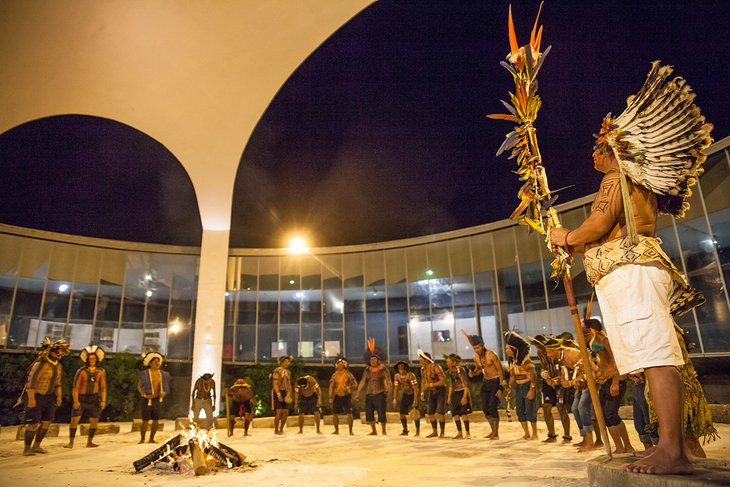
The Museu do Indio has a collection of more than 3,000 objects illustrating the culture and way of life of the indigenous peoples that live or lived along the upper Rio Negro. It is operated by the Salesian Sisters, whose work is dedicated to the peoples of the Upper Amazon.
You'll see displays showing local customs relating to children, agriculture, food, and hunting. The collections represent the peoples from those places where Salesian Sisters worked, mainly the Yanomami, but also tribes from the Mato Grosso, in western central Brazil. This is a good place to visit to buy crafts.
Address: Rua Duque de Caxias 296, Manaus, Amazonas
Parque Nacional do Jaú

The Jaú National Forest is South America's largest forest reserve and the largest protected tropical rainforest area in the world. It covers 2,272,000 hectares along the Rio Negro around Novo Airão, about 250 kilometers northwest of Manaus.
Its extraordinarily rich fauna includes such rare and endangered species as the manatee and the Brazilian otter, as well as jaguars and Amazon River dolphins. The diverse ecosystem includes plains, hills, flooded forests, channels, and land forests.
The best way to explore the park and see wildlife is by canoe through its waterways, and you can stay in jungle lodges.
Alfândega (Customs House) and Floating Dock

Although not open to the public, the Customs House and lighthouse are well worth seeing and are protected as national monuments. The ornate building was imported from Britain in prefabricated form and erected in Manaus in 1902. It stands on the bank of the Rio Negro, near the floating dock, built at the same time.
The dock was designed to accommodate the dramatic changes in river level, which can vary by 10 meters over the course of a year. Today, the dock is one of the city's busiest places, as nearly all transport here is by water.
Address: Marquesa da Santa Cruz St., Manaus, Amazonas




